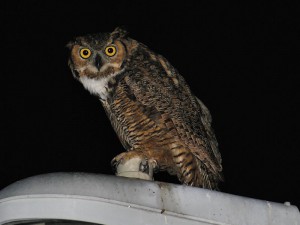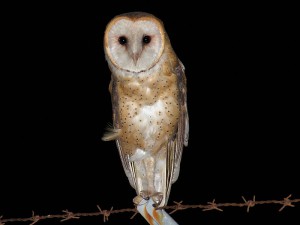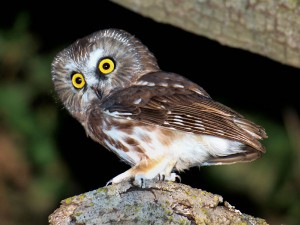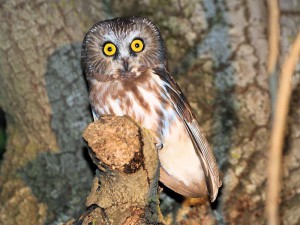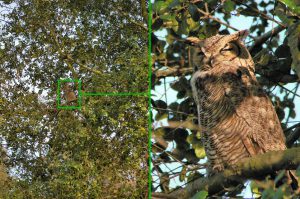Great-Horned Owls
Bruce Aird had birding clients in from Eastern Tennessee. He asked if I would guide them for an evening of local owling. Participants David Johnson and Jean Alexander had a list of four local owls they wanted to see. Great Horned Owl, though common nationwide, happened to be one of their owls of choice. This is our largest owl in Southern California and a very beautiful bird. They are fairly common in the city suburbs. Bruce spotted one very close to Optics4Birding sitting on a light post. I’ll bet a hundred people drove by that owl and no one even noticed it sitting there. Great Horned Owls are probably more often noticed in the city at night because of their typical owl “hoot”. Most people associate the hoot with an owl. It also tends to be fairly bold and is more commonly seen on an exposed day perch.
Barn Owls
The Barn Owl is certainly our most prevalent Southern California “city owl”. We had driven right down the road from here (the Optics4Birding Store), along Irvine Blvd, and immediately spotted a Barn Owl sitting on the perimeter fence of the El Toro MCAS (the “Orange County Great Park”). Getting out of the car and squeaking a little bit brought in two more individuals.
Barn Owls are not common in Tennessee so it was an appropriate target owl while here in So Cal. They are probably more frequent here in CA than any other state. If you watch the vineyards along the Central Valley they frequently have Barn Owl boxes in the fields for rodent control. We see and hear them here in the city all the time. Since they screech rather than hoot, their calls are often not recognized as sounds made by an owl. Barn Owls have a distinctive ghostly white appearance in flight and a unique heart-shaped white facial disk.
Western Screech-Owls
The next two target owls would take us into Silverado Canyon to get into forested habitat. The first of these was Western Screech-Owl. In oak woodlands from lowland to mid elevations, this is certainly the most common owl in the west. We had three or four individuals calling at the first location we stopped. Eventually we got great looks at one individual. The owl was within 20 feet of us. The highly territorial Western Screech Owl is very vocal so it is relatively easy to hear. Yet this owl may not be so easy to see without some practice. I have posted on Western Screech-Owl in this blog previously so did not take pictures of this one. We had one final target we hoped to show our visitors, and that bird, shown in the picture at the left was one that I would never depend on finding in mid September.
Northern Saw-whet Owls
The Northern Saw-whet Owl is a permanent resident in some of the Orange County canyons. Yet it is totally quiet at this time of year. They are small (blackbird size), uncommon, strictly nocturnal, and live in a thick habitat. This makes them almost invisible at this time of year. Even when you can locate them by sound during their vocal/breading period, they are still shy. Most often you only see some small owl whizzing by in the night and never get a good sighting.
Add a dark moonless evening in our owling equation and this bird was going to be a difficult find. I had warned the group that there was not much chance of finding this owl. Never-the-less, in a very short period of looking, we found a beautiful little Saw-whet Owl. This one was less than 20 feet away just sitting on an exposed branch for us to admire. The owl is just too cute and certainly a favorite amongst our local owls! It made for a stupendous ending to our night of owling.

